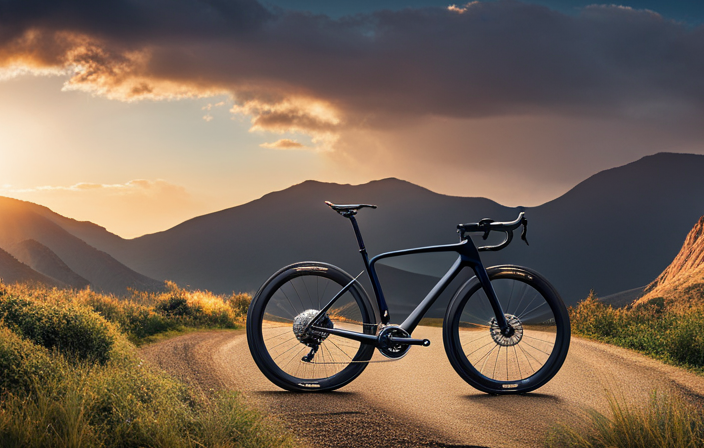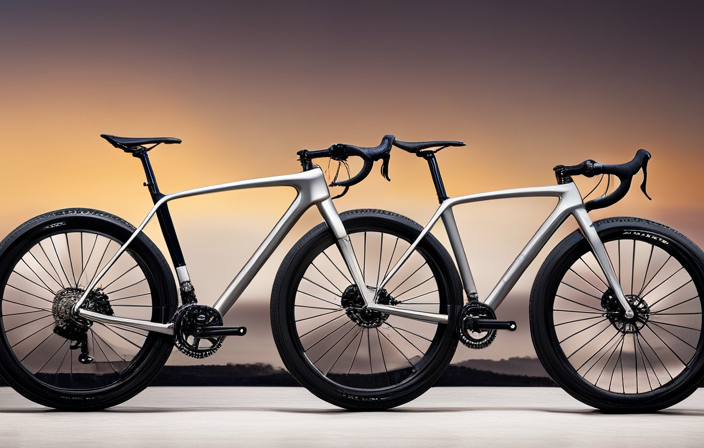Were you aware that selecting the optimal tire pressure for your gravel bike can significantly influence your comfort and maneuverability during rides? Given the multitude of elements to take into account, it’s crucial to comprehend the ways in which tire pressure can shape your biking experience as a whole.
In this article, I will guide you through the process of determining the ideal PSI for your gravel bike tires. We’ll explore different factors to consider, techniques for measurement and adjustment, advice from expert gravel bikers, and the risks of riding with incorrect tire pressure.
So let’s dive in and find the perfect PSI for an optimal gravel biking adventure!
Key Takeaways
- Proper tire pressure is important for comfort, control, and performance in gravel biking.
- Factors such as terrain, rider weight, tire width, and preference influence the optimal tire pressure.
- Adjusting tire pressure based on specific terrains is crucial for traction and efficiency.
- Wider tires generally allow for lower pressures, providing better grip and cushioning on rough surfaces.
Understanding Tire Pressure for Gravel Biking
You should understand tire pressure for gravel biking so you can have a smoother ride. Proper tire pressure is crucial for optimal performance on gravel terrain. To determine the right psi (pounds per square inch) for your gravel bike, you’ll need some measuring tools and knowledge of the factors that come into play.
Start by investing in a good quality pressure gauge. This tool will help you accurately measure the air pressure in your tires. It’s important to note that different bikes and riders may require different pressures, so it’s worth experimenting to find what works best for you.
Finding the optimal tire pressure involves considering various factors. First, consider your weight and riding style. Heavier riders may need higher pressures to prevent pinch flats, while lighter riders can get away with lower pressures for increased traction and comfort.
Next, take into account the terrain you’ll be riding on. Soft or loose surfaces like sand or gravel may require lower pressures to improve traction and stability. On the other hand, hard-packed surfaces might benefit from slightly higher pressures for faster rolling.
In conclusion, understanding tire pressure is essential for a smooth gravel biking experience. By using measuring tools and considering factors such as weight, riding style, and terrain conditions, you can determine the optimal psi for your gravel bike setup.
Factors to Consider When Determining Tire Pressure
When determining tire pressure for gravel biking, there are several factors to consider.
The first factor is the terrain and conditions you will be riding on. Different terrains require different tire pressures. Softer surfaces like loose gravel require lower pressures for better traction and control.
The second factor is your weight as a rider. Heavier riders may need higher pressures to prevent pinch flats. On the other hand, lighter riders can opt for slightly lower pressures for a smoother ride.
Finally, the width and type of your tires also impact the ideal pressure. Wider tires generally allow for lower pressures, while narrower tires may require higher pressures to maintain stability and efficiency on rough terrain.
Terrain and Conditions
For a gravel bike, the recommended psi will depend on the terrain and conditions you plan to ride in. Adjusting tire pressure is essential for optimal performance and safety.
Here are three tips for adjusting tire pressure on different terrains:
-
Soft Terrain: When riding on soft or loose surfaces like sand or mud, lower your tire pressure to increase traction and prevent sinking. A lower psi allows the tires to conform better to the ground, providing more grip.
-
Hard Terrain: On hard-packed surfaces such as gravel roads or pavement, higher tire pressure is recommended. This reduces rolling resistance and improves efficiency while maintaining good handling and preventing flats.
-
Mixed Terrain: If you’ll encounter a variety of terrains during your ride, strike a balance by finding a middle-ground psi that offers reasonable traction without sacrificing speed or stability.
Considering these factors will help optimize your gravel bike’s performance based on the specific conditions you’ll be riding in.
Now let’s explore how rider weight and preference can further influence your tire pressure choices.
Rider Weight and Preference
Taking into account rider weight and preference can greatly impact tire pressure choices.
Rider weight plays a significant role in determining the appropriate psi for a gravel bike. Heavier riders typically require higher tire pressures to support their weight and prevent pinch flats, while lighter riders may be able to ride with lower pressures for improved comfort and traction.
Additionally, rider preference also comes into play when deciding on tire pressure. Some riders prefer a firmer feel with higher pressures, which can provide faster rolling speeds but may sacrifice some comfort. On the other hand, others may prioritize a softer ride with lower pressures, sacrificing some speed for increased traction and cushioning over rough terrain.
Considering both rider weight and tire tread preference is crucial in finding the perfect balance of grip, comfort, and performance.
Moving on to the next section about tire width and type…
Tire Width and Type
The choice of tire width and type greatly influences the performance and handling of my bike. When it comes to gravel biking, there are a few factors to consider.
Firstly, tire pressure recommendations vary depending on the width of the tires. Wider tires generally require lower pressure for optimal performance. This is because wider tires have a larger contact patch with the ground, which increases traction and stability. On the other hand, narrower tires need higher pressures to avoid pinch flats and maintain efficiency.
Additionally, the impact of tire width goes beyond just pressure recommendations. Wider tires provide more cushioning and absorb bumps better, enhancing comfort on rough terrain. They also offer improved grip in corners and better floatation over loose surfaces like gravel or sand.
Finding the right tire pressure is crucial for achieving optimal performance on a gravel bike.
The Importance of Finding the Right Tire Pressure
Finding the right tire pressure is crucial for optimal performance on a gravel bike. Understanding tire pressure’s impact and the benefits of proper tire pressure is essential for every rider. Here are three key factors to consider:
-
Traction: Maintaining the correct tire pressure ensures maximum grip on varying terrain. Too much pressure can cause tires to skid, especially on loose gravel or dirt surfaces, while too little pressure can result in decreased control and increased rolling resistance.
-
Comfort: Proper tire pressure helps absorb vibrations and shocks from rough roads, enhancing overall comfort during long rides. By finding the right balance, you can enjoy a smoother ride without sacrificing speed or efficiency.
-
Efficiency: The right tire pressure optimizes your bike’s performance by reducing rolling resistance. This allows you to maintain higher speeds with less effort, resulting in improved efficiency and endurance.
To measure and adjust tire pressure correctly, it is important to follow specific steps that will be discussed in the next section about how to measure and adjust tire pressure effectively without compromising safety or performance.
How to Measure and Adjust Tire Pressure
To effectively measure and adjust tire pressure, it’s important to follow specific steps for optimal performance and safety.
Measuring tire pressure accurately is crucial because it directly affects the bike’s handling and overall ride quality. When the tires are underinflated, they tend to feel sluggish and can increase rolling resistance, making it harder to pedal efficiently. On the other hand, overinflated tires can cause a harsh ride, reduced traction, and even potential damage to the rims.
To measure tire pressure accurately, start by using a reliable tire gauge that provides precise readings. Remove the valve cap and press the gauge firmly onto the valve stem until you hear a hissing sound. The gauge will display the current pressure reading in PSI (pounds per square inch). If needed, inflate or deflate the tires accordingly until you reach the recommended pressure range specified by your bike manufacturer or tire manufacturer.
Finding the sweet spot for comfort and control is essential for an enjoyable gravel biking experience. By adjusting tire pressure within an appropriate range, you can achieve optimal grip on different surfaces while maintaining a smooth ride. It’s important to strike a balance between higher pressures for reduced rolling resistance on smoother terrain and lower pressures for increased traction on rougher surfaces.
Transitioning into finding that sweet spot will allow us to explore how different variables impact our riding experience further.
Finding the Sweet Spot for Comfort and Control
Achieving the perfect balance between tire pressure and grip is crucial for a comfortable and controlled ride on various surfaces. When it comes to adjusting tire pressure for comfort and control, finding the optimal PSI for different terrains is key.
For gravel biking, where the terrain can vary from smooth dirt roads to loose gravel and everything in between, getting the right tire pressure can make all the difference.
To find the sweet spot, I start by experimenting with different PSI levels. Generally, lower pressures provide more comfort and traction on rougher terrains, as they allow the tires to conform to irregular surfaces. However, going too low can increase the risk of pinch flats or rim damage. On the other hand, higher pressures offer better efficiency and speed on smoother surfaces but may sacrifice some comfort.
I usually begin around 30-40 PSI and then adjust up or down depending on how it feels during my rides. I pay close attention to how much grip I have when cornering and braking as well as how comfortable I feel over bumps and vibrations. By fine-tuning my tire pressure based on these factors, I am able to find that optimal balance between comfort and control.
Transitioning into the impact of tire pressure on performance section: Finding this optimal balance not only enhances my riding experience but also has a significant impact on overall performance.
The Impact of Tire Pressure on Performance
When it comes to tire pressure, you’ll notice a direct impact on your performance. The right tire pressure can make all the difference in terms of speed and control. Measuring equipment such as a digital gauge or floor pump with a pressure gauge is essential to ensure accuracy.
To understand the impact of tire pressure on performance, imagine a gravel bike riding smoothly down the road. Now, picture that same bike with underinflated tires. The ride becomes sluggish and slow, as if pedaling through mud. On the other hand, overinflated tires create a harsh and bumpy ride that reduces control and increases the risk of punctures.
Maintaining the correct tire pressure is crucial for optimal performance. By finding the sweet spot between too soft and too hard, you can enhance your speed on various terrains while maintaining control over your bike.
As we delve into adjusting tire pressure for different terrains, let’s explore how this adjustment affects not only comfort but also overall handling and traction.
Adjusting Tire Pressure for Different Terrains
Finding the right tire pressure for different terrains can greatly impact comfort, handling, and traction on your rides. To adjust tire pressure effectively, it’s essential to have the right measuring tools. A reliable floor pump with a built-in pressure gauge is a great investment for any cyclist. It allows you to accurately measure and adjust your tire pressure according to the specific terrain you’ll be riding on.
When it comes to optimal performance on different terrains, there are a few general guidelines to follow. For smoother surfaces like pavement or hard-packed dirt roads, higher tire pressures within the recommended range are typically preferred. This helps reduce rolling resistance and improves efficiency.
On rougher terrains such as gravel or loose trails, lower tire pressures are often favored. Lower pressures provide better traction by increasing the contact patch between the tire and the ground. This results in improved stability and control over loose surfaces.
Experimenting with different tire pressures for optimal performance is crucial. By adjusting your tire pressure incrementally and taking note of how it affects your ride quality, you can find that sweet spot that offers maximum comfort, handling, and traction for each specific terrain.
Transitioning into experimenting with tire pressure for optimal performance, without using ‘step,’ one can explore various options to determine the most suitable setup for their gravel bike’s tires.
Experimenting with Tire Pressure for Optimal Performance
To get the best performance out of your tires, it’s important to experiment with different tire pressures for optimal results. Tire pressure plays a crucial role in the speed and efficiency of your gravel bike, and finding the right balance can make a significant difference in your riding experience.
When experimenting with different tire pressures, consider these factors:
-
Surface conditions: Adjusting the tire pressure based on the terrain you’ll be riding on is essential. Lower pressures provide better traction and control on loose or rough surfaces, while higher pressures are ideal for smoother roads.
-
Rider weight: Heavier riders may need slightly higher tire pressures to avoid pinch flats, whereas lighter riders can benefit from lower pressures that improve comfort and grip.
-
Riding style: Aggressive riders who tackle technical trails may prefer lower tire pressures for enhanced stability and maneuverability. On the other hand, those focused on speed may opt for higher pressures to reduce rolling resistance.
Experimenting with different tire pressures allows you to fine-tune your gravel bike’s performance according to your specific needs. By understanding how tire pressure affects speed and efficiency, you can find the sweet spot that maximizes both comfort and performance.
Now let’s explore some tips for maintaining consistent tire pressure without compromising on performance.
Tips for Maintaining Consistent Tire Pressure
Here are some tips for keeping your tire pressure consistent and maintaining optimal performance.
Maintaining the proper tire pressure is crucial for a gravel bike as it directly affects its handling, traction, and overall efficiency. The importance of consistency cannot be overstated, as even a slight deviation can significantly impact your riding experience.
Firstly, invest in a good quality floor pump with an accurate pressure gauge. This will allow you to easily check and adjust the tire pressure whenever needed. It’s also essential to regularly inspect your tires for any signs of wear or damage that could affect their ability to hold air properly.
Secondly, make it a habit to check your tire pressure before every ride. Fluctuations in temperature and air leakage over time can cause changes in the tire pressure. By consistently monitoring and adjusting it accordingly, you’ll ensure optimal performance throughout each ride.
Additionally, consider using tubeless tires if you haven’t already made the switch. Tubeless setups provide better puncture protection and allow for lower tire pressures without sacrificing performance. This can enhance comfort and traction on rough terrain while reducing the risk of pinch flats.
In conclusion, maintaining consistent tire pressure is key to maximizing the potential of your gravel bike. By following these tips and staying diligent with regular checks, you’ll enjoy a smoother ride with improved control and efficiency.
Now let’s dive into the role of tubeless vs tubed tires…
The Role of Tubeless vs. Tubed Tires
Switching from tubed tires to tubeless tires can provide several benefits for your riding experience. Here are three advantages of tubeless tires compared to tubed tires:
-
Reduced risk of flats: Tubeless tires eliminate the need for an inner tube, which means there is no chance of pinch flats caused by a punctured tube getting pinched between the rim and tire. This provides enhanced puncture protection and allows you to ride confidently over rough terrain without worrying about flatting.
-
Lower tire pressures: With tubeless tires, you have the freedom to run lower tire pressures without sacrificing performance or risking pinch flats. This increased contact patch with the ground enhances traction, especially on loose surfaces like gravel or dirt.
-
Self-sealing capabilities: Tubeless tires often come equipped with sealant inside that can quickly seal small punctures on-the-go, reducing the chances of a catastrophic flat. This feature not only saves time but also ensures that you can continue your ride without interruptions.
While there are many advantages to using tubeless tires, it’s important to consider some disadvantages as well. These include:
- Initial setup can be more complicated than installing tubed tires.
- The cost of tubeless-compatible rims and compatible tires may be higher.
- In some cases, it may be challenging to find replacement parts or get roadside assistance if needed.
Understanding these pros and cons will help you make an informed decision when choosing between tubed and tubeless tires for your gravel bike.
As we move into discussing common mistakes when setting tire pressure…
Common Mistakes to Avoid When Setting Tire Pressure
One common mistake to avoid when setting tire pressure is not considering the weight of the rider and their gear. Many gravel bikers mistakenly believe that a one-size-fits-all approach to tire pressure will suffice, leading them to overlook this crucial factor. It is important to understand that the weight distribution on a gravel bike can significantly impact tire performance.
Common misconceptions about tire pressure often lead riders to inflate their tires too much or too little. Riding with excessively high pressure may result in reduced traction, discomfort, and increased risk of punctures. On the other hand, riding with insufficient pressure can cause pinch flats and decreased stability during cornering.
To determine the recommended tire pressure ranges for your specific setup, it is advisable to consult your bike manufacturer’s guidelines or seek advice from experienced gravel bikers. These sources can provide valuable insights into optimal pressures based on factors such as rider weight, terrain conditions, and desired comfort level.
In the subsequent section about ‘advice from expert gravel bikers on tire pressure,’ we will delve deeper into understanding how different variables affect tire pressure recommendations and explore strategies for finding the perfect balance between grip, comfort, and performance on various surfaces without compromising safety.
Advice from Expert Gravel Bikers on Tire Pressure
Experienced gravel bikers offer valuable insights on finding the perfect balance between grip, comfort, and performance by adjusting tire pressure according to various variables. When it comes to finding the right tire pressure for your gravel bike, there is no one-size-fits-all solution. It depends on factors such as rider weight, terrain conditions, and personal preference.
Measuring and adjusting tire pressure is essential for optimizing your riding experience. To start, you’ll need a reliable pressure gauge to accurately measure the psi (pounds per square inch) of your tires. Begin with a baseline pressure recommended by the manufacturer and make small adjustments from there.
When riding on rougher terrains or in wet conditions, lowering the tire pressure can increase traction and improve overall control. This allows the tires to conform better to uneven surfaces and maintain contact with the ground.
Conversely, if you’re riding on smoother surfaces or looking for more efficiency during long rides, increasing tire pressure can reduce rolling resistance and enhance speed. However, be cautious not to exceed the maximum recommended pressure indicated on your tire sidewalls.
Understanding how different variables affect tire pressure is crucial for achieving optimal performance on your gravel bike. In the next section about understanding the risks of riding with incorrect tire pressure, we will explore potential consequences that may arise from improper inflation levels without compromising safety or step-by-step instructions.
Understanding the Risks of Riding with Incorrect Tire Pressure
After gathering advice from expert gravel bikers on tire pressure, it is important to understand the risks associated with riding with incorrect tire pressure. Riding with too low or too high of a tire pressure can have serious consequences for your safety and performance on the bike.
If your tire pressure is too low, you run the risk of pinch flats and burping air out of tubeless tires during aggressive maneuvers. This can lead to sudden loss of control and accidents. Additionally, low tire pressure increases rolling resistance, making it harder to maintain speed and efficiency on different terrains.
On the other hand, if your tire pressure is too high, you risk a harsh ride quality that can result in decreased traction. This lack of grip can be particularly dangerous when cornering or braking, as it reduces your ability to control the bike effectively.
Understanding these risks highlights the importance of finding the appropriate tire pressure for your gravel bike. By using a reliable tire pressure gauge, you can ensure that you are riding within safe parameters and optimizing your performance on various surfaces.
Transition: Now that we are aware of the risks associated with incorrect tire pressure, let’s explore the benefits of using a tire pressure gauge for maintaining optimal performance while riding our gravel bikes.
The Benefits of Using a Tire Pressure Gauge
Using a tire pressure gauge ensures that I maintain optimal performance while riding on different terrains. The benefits of using a tire pressure gauge are numerous and cannot be overstated.
Firstly, it allows me to accurately measure the psi (pounds per square inch) of my tires, ensuring that they are inflated to the recommended level. This is crucial because incorrect tire pressure can negatively affect both the ride quality and handling of my gravel bike.
Maintaining the correct tire pressure is important for several reasons. Firstly, it ensures better traction on various surfaces. Whether I’m riding on loose gravel or tackling rough terrain, having the right amount of air in my tires allows them to grip the ground more effectively, reducing the risk of slipping or sliding.
Secondly, using a tire pressure gauge helps prevent punctures and flats. Overinflated tires are more prone to damage from sharp objects as they have less give, while underinflated tires are at a higher risk of pinch flats when hitting obstacles like rocks or curbs.
In addition to these benefits, maintaining proper tire pressure also extends the lifespan of my tires by distributing weight evenly across their surface and preventing excessive wear.
By using a tire pressure gauge, I can ensure that I am reaping all these advantages and enjoying an optimal riding experience on my gravel bike.
Now let’s delve into some final thoughts on finding the perfect psi for gravel biking without compromising safety or performance.
Final Thoughts on Finding the Perfect PSI for Gravel Biking
To ensure a safe and optimal riding experience on different terrains, it’s important to consider some final thoughts on finding the perfect tire pressure for your gravel biking adventures.
Finding the right balance of tire pressure can greatly impact bike handling and stability, allowing you to confidently navigate through various conditions.
Here are four key factors to keep in mind when determining the ideal PSI for your gravel bike:
-
Tire Width: The width of your tires plays a crucial role in determining the appropriate tire pressure. Narrower tires require higher pressures, while wider tires benefit from lower pressures that provide better traction and shock absorption.
-
Rider Weight: Your weight affects how much pressure is exerted on the tires. Heavier riders may need slightly higher pressures to prevent pinch flats, while lighter riders can often get away with lower pressures for increased comfort and grip.
-
Terrain Conditions: Consider the type of terrain you’ll be riding on. Soft or loose surfaces like sand or mud require lower pressures for improved traction, whereas harder surfaces like asphalt or packed dirt may call for slightly higher pressures for better efficiency.
-
Personal Preference: Ultimately, finding the perfect PSI is a matter of personal preference and experimentation. Start by following manufacturer guidelines and make small adjustments based on your individual riding style, comfort level, and desired performance.
By taking these factors into account, you’ll be able to fine-tune your tire pressure to enhance both bike handling and stability during your gravel biking adventures.
Enjoy exploring new trails with confidence!
Frequently Asked Questions
How does tire pressure affect the performance of a gravel bike?
Choosing the right tire pressure for gravel biking is crucial as it directly affects bike handling and stability. Tire pressure determines how much traction you have on different surfaces, such as loose gravel or hard-packed dirt.
Higher pressures provide more speed but less comfort and control, while lower pressures offer better grip and shock absorption but can feel sluggish on smooth terrain.
Finding the ideal balance is key for optimal performance and a smooth ride.
What are the risks of riding with incorrect tire pressure?
Riding with incorrect tire pressure poses several risks. Underinflated tires can lead to increased rolling resistance, making it harder to maintain speed and efficiency on gravel surfaces. This can also cause pinch flats or damage to the sidewalls of the tires.
On the other hand, overinflated tires may result in a harsh and uncomfortable ride, reducing traction and control on uneven terrain. Additionally, overinflation increases the risk of punctures or blowouts due to decreased shock absorption.
It is crucial to find the right tire pressure for optimal performance and safety.
Is there a specific tire pressure gauge that is recommended for gravel biking?
For gravel biking, it’s important to have the correct tire pressure in order to optimize performance and prevent any mishaps on rough terrains.
While there isn’t a specific tire pressure gauge recommended solely for gravel biking, it’s advisable to invest in a high-quality digital gauge that provides accurate readings.
This will ensure that you are able to consistently monitor and maintain the best tire pressure for your gravel bike, enhancing your riding experience and safety.
How often should tire pressure be checked and adjusted?
To determine the ideal tire pressure for a gravel bike, it’s important to consider factors such as rider weight, terrain conditions, and personal preference. Checking and adjusting tire pressure should be done regularly, especially before each ride.
Proper tire pressure affects comfort and traction on gravel roads. Higher pressures provide better rolling efficiency on smooth surfaces but decrease comfort and traction on rough terrain. Conversely, lower pressures increase comfort and traction but may result in higher rolling resistance.
Experimenting with different pressures is key to finding the perfect balance for your gravel biking experience.
Are there any specific tips for maintaining consistent tire pressure on a gravel bike?
Maintaining tire pressure on a gravel bike is crucial for optimal performance and safety. To ensure consistent tire pressure, there are a few best practices to follow.
Firstly, always check your tire pressure before each ride using a reliable gauge.
Secondly, consider investing in a high-quality floor pump with accurate pressure measurements.
Additionally, make it a habit to inspect your tires regularly for any signs of wear or damage that could affect pressure.
By following these tips, you can maintain optimal tire pressure and enjoy smooth rides on your gravel bike.
Conclusion
After delving into the world of gravel biking and exploring the intricacies of tire pressure, it’s clear that finding the perfect PSI is crucial for a comfortable and controlled ride.
By understanding factors such as terrain, rider weight, and tire width, you can make informed decisions about tire pressure.
Utilizing a tire pressure gauge ensures accuracy and reduces the risk of riding with incorrect PSI.
So, why settle for anything less than optimal tire pressure when you could enhance your gravel biking experience?









